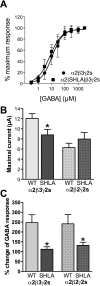Inhaled anesthetic responses of recombinant receptors and knockin mice harboring α2(S270H/L277A) GABA(A) receptor subunits that are resistant to isoflurane
- PMID: 20807777
- PMCID: PMC3014300
- DOI: 10.1124/jpet.110.170431
Inhaled anesthetic responses of recombinant receptors and knockin mice harboring α2(S270H/L277A) GABA(A) receptor subunits that are resistant to isoflurane
Abstract
The mechanism by which the inhaled anesthetic isoflurane produces amnesia and immobility is not understood. Isoflurane modulates GABA(A) receptors (GABA(A)-Rs) in a manner that makes them plausible targets. We asked whether GABA(A)-R α2 subunits contribute to a site of anesthetic action in vivo. Previous studies demonstrated that Ser270 in the second transmembrane domain is involved in the modulation of GABA(A)-Rs by volatile anesthetics and alcohol, either as a binding site or a critical allosteric residue. We engineered GABA(A)-Rs with two mutations in the α2 subunit, changing Ser270 to His and Leu277 to Ala. Recombinant receptors with these mutations demonstrated normal affinity for GABA, but substantially reduced responses to isoflurane. We then produced mutant (knockin) mice in which this mutated subunit replaced the wild-type α2 subunit. The adult mutant mice were overtly normal, although there was evidence of enhanced neonatal mortality and fear conditioning. Electrophysiological recordings from dentate granule neurons in brain slices confirmed the decreased actions of isoflurane on mutant receptors contributing to inhibitory synaptic currents. The loss of righting reflex EC(50) for isoflurane did not differ between genotypes, but time to regain the righting reflex was increased in N(2) generation knockins. This effect was not observed at the N(4) generation. Isoflurane produced immobility (as measured by tail clamp) and amnesia (as measured by fear conditioning) in both wild-type and mutant mice, and potencies (EC(50)) did not differ between the strains for these actions of isoflurane. Thus, immobility or amnesia does not require isoflurane potentiation of the α2 subunit.
Figures







Similar articles
-
Gamma-aminobutyric acid type A receptor alpha 4 subunit knockout mice are resistant to the amnestic effect of isoflurane.Anesth Analg. 2009 Dec;109(6):1816-22. doi: 10.1213/ANE.0b013e3181bf6ae6. Anesth Analg. 2009. PMID: 19923508 Free PMC article.
-
Effect of isoflurane and other potent inhaled anesthetics on minimum alveolar concentration, learning, and the righting reflex in mice engineered to express alpha1 gamma-aminobutyric acid type A receptors unresponsive to isoflurane.Anesthesiology. 2007 Jan;106(1):107-13. doi: 10.1097/00000542-200701000-00019. Anesthesiology. 2007. PMID: 17197852
-
Gamma-aminobutyric acid type A receptor β3 subunit forebrain-specific knockout mice are resistant to the amnestic effect of isoflurane.Anesth Analg. 2011 Sep;113(3):500-4. doi: 10.1213/ANE.0b013e3182273aff. Epub 2011 Aug 3. Anesth Analg. 2011. PMID: 21813630 Free PMC article.
-
An isoflurane- and alcohol-insensitive mutant GABA(A) receptor alpha(1) subunit with near-normal apparent affinity for GABA: characterization in heterologous systems and production of knockin mice.J Pharmacol Exp Ther. 2006 Oct;319(1):208-18. doi: 10.1124/jpet.106.104406. Epub 2006 Jun 28. J Pharmacol Exp Ther. 2006. PMID: 16807363
-
Is a new paradigm needed to explain how inhaled anesthetics produce immobility?Anesth Analg. 2008 Sep;107(3):832-48. doi: 10.1213/ane.0b013e318182aedb. Anesth Analg. 2008. PMID: 18713892 Free PMC article. Review.
Cited by
-
Anxiety and depression: mouse genetics and pharmacological approaches to the role of GABA(A) receptor subtypes.Neuropharmacology. 2012 Jan;62(1):54-62. doi: 10.1016/j.neuropharm.2011.07.026. Epub 2011 Jul 27. Neuropharmacology. 2012. PMID: 21810433 Free PMC article. Review.
-
Identification of binding sites contributing to volatile anesthetic effects on GABA type A receptors.FASEB J. 2018 Aug;32(8):4172-4189. doi: 10.1096/fj.201701347R. Epub 2018 Mar 5. FASEB J. 2018. PMID: 29505303 Free PMC article.
-
Effects of General Anesthetics on Synaptic Transmission and Plasticity.Curr Neuropharmacol. 2022;20(1):27-54. doi: 10.2174/1570159X19666210803105232. Curr Neuropharmacol. 2022. PMID: 34344292 Free PMC article. Review.
-
Anesthetic agent-specific effects on synaptic inhibition.Anesth Analg. 2014 Sep;119(3):558-569. doi: 10.1213/ANE.0000000000000321. Anesth Analg. 2014. PMID: 24977633 Free PMC article.
-
Isoflurane enhances both fast and slow synaptic inhibition in the hippocampus at amnestic concentrations.Anesthesiology. 2012 Apr;116(4):816-23. doi: 10.1097/ALN.0b013e31824be0e3. Anesthesiology. 2012. PMID: 22343472 Free PMC article.
References
-
- Alifimoff JK, Firestone LL, Miller KW. (1987) Anesthetic potencies of secondary alcohol enantiomers. Anesthesiology 66:55–59 - PubMed
-
- Antognini JF, Schwartz K. (1993) Exaggerated anesthetic requirements in the preferentially anesthetized brain. Anesthesiology 79:1244–1249 - PubMed
-
- Borghese CM, Werner DF, Topf N, Baron NV, Henderson LA, Boehm SL, 2nd, Blednov YA, Saad A, Dai S, Pearce RA, et al. (2006) An isoflurane- and alcohol-insensitive mutant GABAA receptor α1 subunit with near normal apparent affinity for GABA: characterization in heterologous systems and production of knock-in mice. J Pharmacol Exp Ther 319:208–218 - PubMed
Publication types
MeSH terms
Substances
Grants and funding
LinkOut - more resources
Full Text Sources
Molecular Biology Databases
Research Materials

